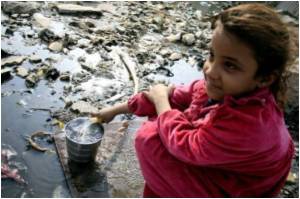For the first time Canadian-based researchers quantified the effect of unsafe water and sanitation on mortality of children below five and mothers in the year after childbirth.

Using regression analysis techniques to factor out other variables like income and average children per mother, they compared safe water and sanitation rates with maternal and child deaths in those countries.
Dividing the 193 countries into four tiers ("quartiles"), they found that countries ranked in the bottom 25% in terms of safe water had about 4.7 more deaths per 1,000 children under five years old compared to countries in the top 25% tier.
The researchers estimate that, when related to safe water access, the difference in mortality between each 25% tier is 1.17 deaths per 1,000 children under five.
Similarly, when judged on access to adequate sanitation, countries ranked in the bottom 25% tier had about 6.6 more deaths per 1,000 children under five years old compared to countries in the top 25% tier.
Put another way, with respect to the availability of adequate sanitation, the difference in mortality between each of the four tiers of countries is estimated at 1.66 deaths per 1,000 children under five.
Advertisement
"If the world is to seriously address the Millennium Development Goals of reducing child and maternal mortality, then improved water and sanitation accesses are key strategies," say Hamilton Canada-based authors June J. Cheng, Susan Watt and Bruce K. Newbold of McMaster University, Andrew Mente of the Population Heath Research Institute, and Corinne J. Schuster-Wallace of UNU's Institute for Water, Environment and Health, which initiated the study.
Advertisement
Earlier World Health Organization (WHO) reports have stated that almost 10% of the global disease burden could be prevented by improving water supply, sanitation, hygiene and management of water resources. Another estimate reports that 4.0% of all deaths and 5.7% of total disability-adjusted life years can be attributed to water, sanitation and hygiene.
Despite progress, previous UN research has shown that, at the current pace, the world will miss the Millennium Development Goal (MDG) for sanitation by 13%, with 2.7 billion people still lacking basic sanitation by 2015. Even if the target was met, 1.7 billion people would still lack access to improved sanitation.
More positively, the world will meet the water MDG target at the current rate. However, even if that forecast is realized by 2015, some 672 million people will still lack access to safe water.
Source-Eurekalert













